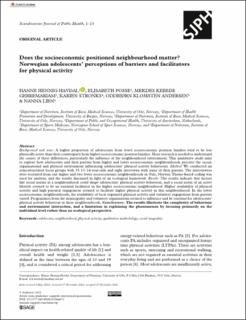| dc.contributor.author | Havdal, Hanne Hennig | |
| dc.contributor.author | Fosse, Elisabeth Minda | |
| dc.contributor.author | Gebremariam, Mekdes | |
| dc.contributor.author | Stronks, Karien | |
| dc.contributor.author | Andersen, Oddbjørn Klomsten | |
| dc.contributor.author | Lien, Nanna | |
| dc.date.accessioned | 2022-06-28T07:50:21Z | |
| dc.date.available | 2022-06-28T07:50:21Z | |
| dc.date.created | 2022-05-02T16:04:23Z | |
| dc.date.issued | 2022 | |
| dc.identifier.issn | 1403-4948 | |
| dc.identifier.uri | https://hdl.handle.net/11250/3001219 | |
| dc.description.abstract | Background and aims: A higher proportion of adolescents from lower socioeconomic position families tend to be less physically active than their counterparts from higher socioeconomic position families. More research is needed to understand the causes of these differences, particularly the influence of the neighbourhood environment. This qualitative study aims to explore how adolescents and their parents from higher and lower socioeconomic neighbourhoods perceive the social, organisational and physical environment influencing adolescents’ physical activity behaviours. Method: We conducted six semi-structured focus groups with 35 13–14-year-olds and eight interviews with some of their parents. The interviewees were recruited from one higher and two lower socioeconomic neighbourhoods in Oslo, Norway. Theme-based coding was used for analysis, and the results discussed in light of an ecological framework. Results: The results indicate that factors like social norms in a neighbourhood could shape adolescents’ physical activity behaviour, and a social norm of an active lifestyle seemed to be an essential facilitator in the higher socioeconomic neighbourhood. Higher availability of physical activity and high parental engagement seemed to facilitate higher physical activity in this neighbourhood. In the lower socioeconomic neighbourhoods, the availability of local organised physical activity and volunteer engagement from parents varied. Programmes from the municipality and volunteer organisations seemed to influence and be essential for adolescents’ physical activity behaviour in these neighbourhoods. Conclusions: The results illustrate the complexity of behaviour and environment interaction, and a limitation in explaining the phenomenon by focusing primarily on the individual level rather than an ecological perspective. | en_US |
| dc.language.iso | eng | en_US |
| dc.publisher | SAGE | en_US |
| dc.rights | Navngivelse 4.0 Internasjonal | * |
| dc.rights.uri | http://creativecommons.org/licenses/by/4.0/deed.no | * |
| dc.title | Does the socioeconomic positioned neighbourhood matter? Norwegian adolescents’ perceptions of barriers and facilitators for physical activity | en_US |
| dc.type | Journal article | en_US |
| dc.type | Peer reviewed | en_US |
| dc.description.version | publishedVersion | en_US |
| dc.rights.holder | Copyright 2022 the authors | en_US |
| cristin.ispublished | true | |
| cristin.fulltext | original | |
| cristin.qualitycode | 1 | |
| dc.identifier.doi | 10.1177/14034948211066673 | |
| dc.identifier.cristin | 2020789 | |
| dc.source.journal | Scandinavian Journal of Public Health | en_US |
| dc.identifier.citation | Scandinavian Journal of Public Health. 2022. | en_US |

